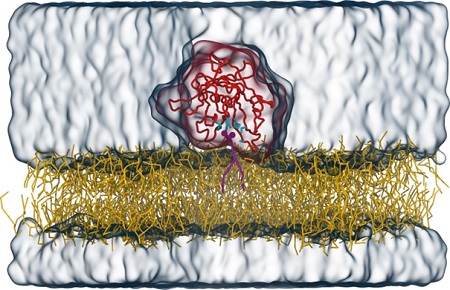New binding site to the cell membrane identified for Tubby protein
The molecular dynamics group headed by Siewert-Jan Marrink investigates the interactions of proteins and lipids (fats) in membranes by means of simulations. In collaboration with researchers from Germany, they identified a previously unknown lipid binding site in the barrel-shaped Tubby protein that could help to understand various diseases.
If the Tubby protein does not work, disturbances in the energy balance, obesity, degeneration of the retina, and hearing loss can occur. The exact background for these malfunctions is unclear, therefore insights in the functioning of Tubby are important. The Tubby protein family plays a key role in the transport of proteins within the cell membrane. They bind receptor proteins and channel them into fine hairs, the primary cilia. These cilia act as antennae that use the receptor proteins to recognise signals outside the cell and transmit them into the cell interior. If the function of the Tubby protein is lost, and receptor proteins are no longer transported, signal transmission is disturbed. This can result in diseases.

Mutations
For Tubby to function as a transporter, it must dock to the inside of the membrane via a specific lipid (called PI(4,5)P2) that is found exclusively in the cell membrane. A team led by Dr. Sebastian Thallmair (Frankfurt Institute for Advanced Studies), Prof. Dr. Dominik Oliver (University of Marburg), and Prof. Dr. Siewert-Jan Marrink (University of Groningen, The Netherlands) investigated the binding mechanism of Tubby to this signalling lipid in more detail. In their current publication, they describe a previously unknown second binding site of the Tubby protein. ‘Using computational modelling, we identified a second binding pocket for the signalling lipid, in addition to the one we already know’, says Sebastian Thallmair.
To validate the modelling results, the team placed mutations in the predicted binding site, which stopped in from functioning properly. This confirmed that the second binding pocket is essential for Tubby's function in living cells. It plays a key role in enabling Tubby to dock to the cell membrane. Furthermore, the team showed that both binding sites cooperate. ‘This means that, surprisingly, two bound signalling lipids act more than twice as strongly as just one bound signalling lipid’, explains Thallmair.
Fluorescently labelled Tubby protein is also used as a marker to draw conclusions about the lipid concentration of different membrane areas. ‘For instance, we would like to understand how the signalling lipid is re-synthesised after it has been degraded’, says Thallmair. ‘It is obviously only synthesised in certain, narrowly defined areas of the cell membrane.’ Tubby should help to identify these areas.
Reference: Veronika Thallmair, Lea Schultz, Wencai Zhao, Siewert-Jan Marrink, Dominik Oliver, Sebastian Thallmair: Two cooperative binding sites sensitize PI(4,5)P2 recognition by the tubby domain. Science Advances 8, 7 September 2022
Text: Philipps-University Marburg
| Last modified: | 07 February 2025 12.32 p.m. |
More news
-
06 May 2025
Overcoming grid congestion: ‘Making better use of what we already have’
Grid congestion poses a major problem. There is little to no capacity to connect new households and businesses to the power grid and it risks halting the energy transition. Michele Cucuzzella, Associate Professor of Energy Systems & Nonlinear...
-
29 April 2025
Impact | Rubber recycling
In the coming weeks the nominees for the Ben Feringa Impact Award 2025 will introduce themselves and their impactful research or project. This week: Francesco Picchioni on his innovative way to recycle rubber.
-
29 April 2025
Impact | Improving Human-AI Decision-Making in healthcare
In the coming weeks the nominees for the Ben Feringa Impact Award 2025 will introduce themselves and their impactful research or project. This week: Andra Cristiana Minculescu on her research project on Human-AI Decision-Making in healthcare.
